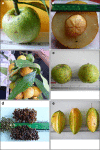Antioxidant properties, physico-chemical characteristics and proximate composition of five wild fruits of Manipur, India
- PMID: 25694698
- PMCID: PMC4325057
- DOI: 10.1007/s13197-013-1128-2
Antioxidant properties, physico-chemical characteristics and proximate composition of five wild fruits of Manipur, India
Abstract
Antioxidant properties, physico-chemical characteristics and proximate composition of five wild fruits viz., Garcinia pedunculata, Garcinia xanthochymus, Docynia indica, Rhus semialata and Averrhoa carambola grown in Manipur, India were presented in the current study. The order of the antioxidant activity and reducing power of the fruit samples was found as R. semialata > D. indica > G. xanthochymus > A. carambola > G. pedunculata. Good correlation coefficient (R(2) > 0.99) was found among the three methods applied to determine antioxidant activity. Total phenolic content was positively correlated (R(2) = 0.960) with the antioxidant activity however, total flavonoid content was not positively correlated with the antioxidant activity. Physico-chemical and proximate composition of these fruits is documented for the first time.
Keywords: Antioxidant activity; Averrhoa carambola; Docynia indica; Garcinia pedunculata; Garcinia xanthochymus; Rhus semialata.
Figures



References
-
- AOAC . Official methods of analysis of AOAC (Association of Official Agricultural Chemists) Arlington: International Method 993.21; 1995.
-
- AOAC . Official methods of analysis: Method 942.15. 17. Gaithersburg: AOAC International; 2000.
-
- AOAC . Official methods of analysis. 17. Gaithersburg: AOAC International; 2003.
-
- Campbell RM, Dymshitz J, Eastwood BJ, et al. Data standardization for results management. Indianapolis: Eli Lilly & Company; 2012.
LinkOut - more resources
Full Text Sources
Other Literature Sources
